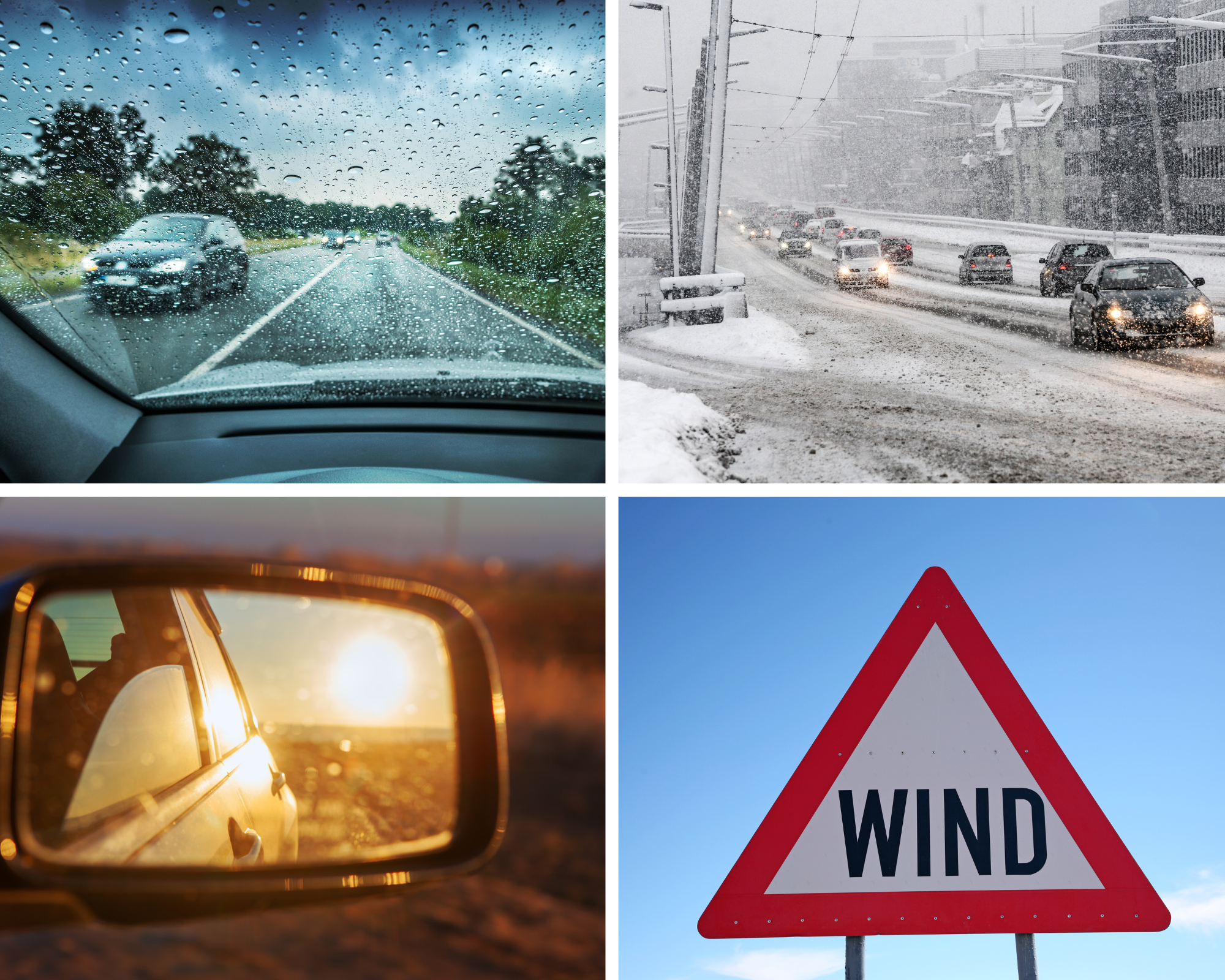
All weather driving
August 03, 2023
It doesn’t matter what the weather is, always make sure your vehicle and equipment are in good condition and regularly checked and serviced.
In bad weather the condition of your vehicle is even more important, especially your tyres and brakes. Different weather conditions can lead to a variety of different hazards, both from season to season and from region to region.
Tyres
Check tyre condition and pressures frequently. Make sure that the tyres have a good tread, that the walls are undamaged and that they’re inflated to the correct pressure
Also check your tyres for uneven wear of the tread, either across or around the tyre which could be due to a mechanical defect Have your vehicle checked , any fault put right and a new tyre fitted if necessary. Good tyres are especially important in snow, icy roads and in heavy rain. Be prepared ; do not wait until bad weather shows up the deficiency- it might to late and your life could depend on a few millimetres of rubber which should have been there.
Brakes
Make sure that you keep your brakes in top condition. Stopping takes much longer on wet, slippery roads even with perfect brakes.
Ensuring a clear view.
The biggest single danger to any driver is being unable to see properly. You wont be able to make the right decisions if you cant see the road clearly.
Always keep your windscreen, mirrors and windows clean and clear
Wipers and washers
Make sure your wiper blades are effective.
Make sure washes are working and keep the reservoir filled. Use an additive, as it helps
to prevent freezing water
to clear dead insects and smears off the windscreen in summer.
Misting up
Misting up of the mirror and glass inside the effects your ability to see. Even on a bright summers day a sudden shower can make the glass mist up inside.
Keep a dry cloth handy and clean all inside glass
wipe the windows dry before you set out
Use demisters if your car has a heated windscreen , use it early. Also use your heated rear window to maintain your rear vision.
Open your windows to clear mist, if necessary
If your car is fitted with air conditioning this can assist with clearing windows
Read your vehicle handbook and follow the makers suggestions for effective heating and ventilation
A lot of anti-mist and anti -frost accessories are available, including
liquid from keeping glass clear
de-icers
prepared cloths
electrically heated glass
Warm dry air works best, is by far cheapest and is usually in plentiful supply once the engine has warmed up
However, when you start from cold , you wont be able to create warm air so use a dry cloth or a chamois leather. If you have a passenger, you can ask them to help keep the side windows clear- this essential when manoeuvring.
Icy weather
If the weather is particularly icy your windows and windscreen can be frozen over. Give your self plenty of time to clear the windscreen. Before setting out , wait until your demister and heater are working well enough to keep the whole of the windscreen and rear window clear.
Take care not damage wiper blades, which may have frozen onto the windscreen or rear window. Never use boiling water to clear the windscreen as you could break the glass. Use water that is barely lukewarm or even cold - this is still warmer than ice and it will start this defrosting process.
Rain
Use dipped headlights in poor visibility ( such as rain, drizzle, mist, or very poor light) so that other drivers can see you. Rain can drastically reduce your view through the windscreen and windows and int he outside driving mirror.
The cleaner the glass, the sooner the wipers can clear the outside of the screen Always keep the washer bottle topped up.
Remember to keep your speed down in very wet weather conditions. Some windscreen wipers may not be efficient enough to deal with very heavy rain. In dirty weather conditions , clean your windscreen, windows, indicators and lights as often as necessary
Wet Road
Stopping distance
Wet roads tyre grip, so slow down. Make sure that you give yourself plenty of time and room for slowing down and stopping. Keep well back from other vehicles. On a wet road, you should allow at least double the braking distance for dry road.
After a spell of dry weather, rain on the road can make the surface even more slippery. Take extra care, especially when cornering. Be aware that different road surfaces might affect the grip of your tyres.
Remember, the less thread on your tyres, the greater increase in braking distance.
Consider others
Pedestrians and cyclists can easily get drenched by passing vehicles. Look well ahead and show consideration by slowing down or giving them more room when its safe to do so. Also give cyclists room to pull out to avoid large puddles.
Aquaplaning
A great danger when driving at speed in very we weather is the build up of water between the tyre and the road surface. As a result your vehicles actually slides forwards on a thin film of water as your tyres lose contact with the road surface. This is called aquaplaning . Even good tyres can not grip in this situation.
A clear indication that you are aquaplaning can be that the steering suddenly feels very light. When this happens, slow down by easing off the accelerator. Never brake or try to change direction, because your are aquaplaning. You have no control at all over steering or braking.
The higher your speed on a wet surface/road the more likely you are to aquaplane. You must keep your speed down and watch for water pooling on road surfaces.
Even at lower speeds, if the front and rear tyres on one side of the vehicle hit a patch of deeper water, the vehicle may swerve because of the additional resistance on that side
Spray
Another reason to keep your speed down on wet roads is the amount of water thrown up by other vehicles.
Overtaking or being over taken by heavy vehicles on the motorway can be an unnerving experience.
If necessary slow down to increase the distance between you and the large vehicle, remembering to look in your mirrors before you do so. Sometimes wipers can not keep the windscreen clear even when working at full speed. This results in the driver being temporarily blinded to conditions ahead you may need to slow down. If water sprays up under the bonnet, it can stop the engine or affect the electronic controls.
Dealing with floods
When passing through a flood, take your time. Stop and assess how seep the water is. Don’t just drive into it. Some roads that are likely to flood have depth gauges. Check the depth on these
Deep water
If the water seems too deep for your vehicle, turn back and go around the flood y another road. It might take you a little bit longer but its better than being stranded.
If the water is too deep it could
flood the exhaust, causing engine failure
find its way into air intake on some vehicles, causing serious engine damage.
Shallow water
if the water is not too deep drive slowly through it but be sure to keep to the shallowest part. Remember because the camber of the road , water is probably deepest near the kerb and shallowest at the top.
Driving through floodwater.
Drive in first gear as slowly as possible but keep the engine speed high and steady by slipping the clutch.
if the engine speed is too low , you might stall
if you go too fast, you could create a bow wave. This will make water flood the engine and then your car could cut out.
Try to strike a balance.
Engines and water
Some types of diesel engine will tolerate a certain amount of water, but many modern fuel systems are electronically controlled and are, therefore affected by water.
All petrol engines can be seriously affected by even small amounts of water being splashed onto the electrical components these can include engine management systems , coil, distributor, leads and so on.
Crossing a Ford
The depth of water at a ford varies with the weather and is usually greater in winter. There may be a depth gauge in the area. If water is not too deep for your vehicle cross using the same technique as you would a flood.
Remember to test your brakes after you cross. There might be a notice reminding you to do so.
Do not try to displace the water by charging at the flood or ford.
you could loose control
your vehicle will probably stall.
you could end up blocking the road.
Test your brakes
Water can reduce the effectiveness of your brakes, so test your brakes whenever you’ve passed through water on the road. When you’ve driven safely through, check your mirrors first and then test your brakes.
If they do not work properly, it will help to dry them out if you apply light pressure tot he brake pedal while driving along slowly. Do not drive at normal speed until you are sure that they are working properly
Posted in On the road by Myewelily Kareen Kezia Malcolm
